

|

|

|

|

|

|

|

|
|
~~~~~~ World Bibliography of Beliefs, Theories and Theologies ~ click pix to enlarge ~~~~~~ Roman Catholic Church Members 1,114,966,000 The Catholic Church or Roman Catholic Church is a Christian church in full communion with the Bishop of Rome, currently Pope Benedict XVI. Through apostolic succession, it traces its origins to the original Christian community founded by Jesus in his act of consecration of Saint Peter as the first pope. Together with its main mission to preach the Gospel and administer the sacraments, the Church administers numerous social programs and ministries in countries throughout the world. These programs include schools, universities, hospitals, shelters, ministries to the poor, families, elderly, sick and marginalized. Church belief is encapsulated in the Nicene Creed and detailed in a book called the Catechism of the Catholic Church. Liturgy is regulated by church authority with Catholic Mass (Eucharist) considered the center of Catholic worship. The worldwide Catholic Church is made up of one Western or Latin and 22 Eastern Catholic autonomous particular churches, all of which look to the Pope, alone or along with the College of Bishops, as their highest authority on earth for matters of faith, morals and church governance. It is divided into jurisdictional areas each called a diocese in the Latin church or an eparchy in the Eastern churches. Each diocese or eparchy is headed by a bishop, patriarch or eparch who is appointed with final approval by the pope. At the end of 2006, the total number of all these jurisdictional areas (or "Sees") was 2,782. |
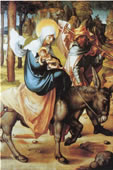
|
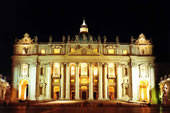
|
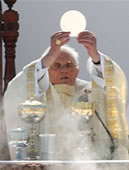
|

|

|
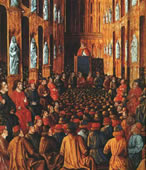
|
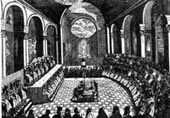
|

|
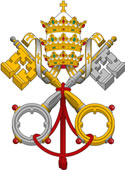
|
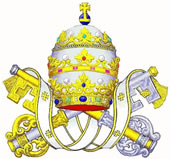
|

|

|

|

|
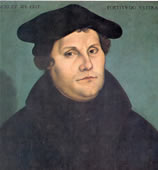
|

|
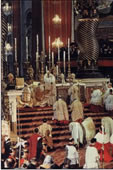
|
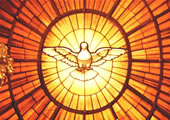
|
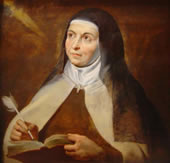
|
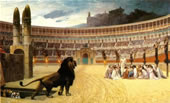
|
|
Church history has been intimately intertwined with the history of Western civilization affecting beliefs and practices of Christians and non-Christians alike for the past 2000 years. The Catholic Church is the largest Christian church, representing over half of all Christians, and is the largest organized body of any world religion. According to the Statistical Yearbook of the Church, the Catholic Church’s worldwide recorded membership at the end of 2005 was 1,114,966,000, approximately one-sixth of the world’s population. Origin and Mission A 15th century painting depicting Jesus giving the Keys of Heaven to Saint Peter (cf. Matthew 16:17-19).Main articles: History of the Roman Catholic Church and History of the Papacy The church traces its origins to Jesus and the Twelve Apostles, and sees the bishops of the church as the successors of the Apostles in general, and the Pope as the successor of Saint Peter, leader of the Apostles, in particular. The Gospel of Matthew 16 gives the account of Christ’s consecration of Peter with the words "...you are Peter, and upon this rock I will build my church, and the gates of the netherworld shall not prevail against it. I will give you the keys to the kingdom of heaven. Whatever you bind on earth shall be bound in heaven; whatever you loose on earth shall be loosed in heaven." The church mission is taken from Jesus’ instruction to his apostles to "Go therefore and make disciples of all nations, baptizing them in the name of the Father, and of the Son and of the Holy Spirit, teaching them to observe all that I have commanded you: and Lo, I am with you always, until the close of the age." After his death and resurrection, Jesus appears to Peter asking him to "feed my sheep" and "tend my sheep". The church believes it fulfills these mandates by preaching the Gospel and administering the sacraments. The Church supplements its preaching and sacramental duties by administering numerous social programs in countries throughout the world. Through catholic schools, universities, hospitals, shelters, ministries to the poor, families, elderly and marginalized, and various lay ministries, the Church tends to both corporal and spiritual needs of "the sheep". Beliefs Catholic belief on all subjects is summarized in a book published by the Vatican called the Catechism of the Catholic Church. Eastern Orthodox belief differs from Roman Catholics mainly on the issues of papal infallibility, the filioque clause and the immaculate conception of Mary but are otherwise quite similar. The beliefs of Protestant churches vary, but they generally differ from Catholic beliefs on the authority of the Pope and of church tradition, the role of Mary and the saints, the role of the priesthood, and issues pertaining to grace, good works and salvation. The five solas were one attempt to express these differences. Creed The Nicene Creed and the Apostles’ Creed, state the main principles of basic Christian and Catholic belief. The contents of the Apostles’ Creed are entirely contained in the Nicene Creed which is what is recited in all the Eastern and Western Catholic Masses today as well as the majority of all worldwide Christian churches regardless of denomination. This creed states: "We believe in one God, the Father, the Almighty, maker of heaven and earth, of all that is, seen and unseen. We believe in one Lord, Jesus Christ, the only Son of God eternally begotten of the Father, God from God, Light from Light, true God from true God, begotten, not made, one in Being with the Father. Through him all things were made. For us men and for our salvation he came down from heaven: by the power of the Holy Spirit he was born of the Virgin Mary, and became man. For our sake he was crucified under Pontius Pilate; he suffered, died, and was buried. On the third day he rose again in fulfillment of the Scriptures; he ascended into heaven and is seated at the right hand of the Father. He will come again to judge the living and the dead, and his kingdom will have no end. We believe in the Holy Spirit, the Lord, the giver of life, who proceeds from the Father and the Son. With the Father and the Son he is worshiped and glorified. He has spoken through the Prophets. We believe in one holy catholic and apostolic Church. We acknowledge one baptism for the forgiveness of sins. We look for the resurrection of the dead and the life of the world to come." Spiritual realm and sin Saint Michael is one of the three archangels.Catholic belief includes the existence of spiritual beings called angels. These beings are God’s servants and messengers. They are purely spiritual creatures that have intelligence, will, and immortality.". A certain number of angels chose to reject God and his reign. This event is called the "Fall of the Angels". Jesus calls the leader of this group of fallen angels the "father of lies". It is through this "father of lies" that the first humans are tempted and commit original sin. Originally created to live in union with God, these first humans, Adam and Eve brought sin and death into the world by committing this original sin. The event, called The Fall of Man, left humans separated from their original state of intimacy with God. This state of separation followed the soul into death. The Catechism states that "The account of the fall in Genesis 3 uses figurative language, but affirms ...a deed that took place at the beginning of the history of man". According to the Catechism, original sin is to each individual soul "a deprivation of original holiness and justice..." that makes each person "subject to ignorance, suffering, and the dominion of death: and inclined to sin..." The sacrament of Baptism is the means by which people can be cleansed from this original sin. Jesus preaching his Sermon on the MountJesus preaches that his way leads to the fullness of life and love and following him leads the person to this fullness. Sin is the opposite of following Jesus and leads the soul to infinite unhappiness. The church teaches that sin robs man of his resemblance to God. Failing to love God and our neighbor and instead, doing harm to them, not following the Ten Commandments are some ways that people can commit sin. Some sins are more serious than others. Mortal sins drive God out of the life of a person’s soul. For a sin to be mortal, three conditions must be met: "Mortal sin is sin whose object is grave matter and which is also committed with full knowledge and deliberate consent". Jesus and Holy Spirit The Holy Spirit is often depicted in art as a dove in reference to John the Baptist’s proclamation that he saw the Holy Spirit descend upon Jesus at his baptism "like a dove".Christians believe that the mission of Jesus included giving us his Word and example to follow. A person is helped not to fall into sin and to do good instead by following the words and example of Jesus Christ which are found in the four Gospels. The Gospel of John refers to Jesus as "The Word" who is God and who was with God from the beginning and through whom all things were made.." Furthermore, in the messianic texts of the Jewish Torah, which is also the Christian Old Testament, God promises to send his people a savior who will give his life as an offering for sin. This promise, according to Catholics is fulfilled in Jesus, the "lamb of God who takes away the sin of the world". Through his suffering, all humankind have an opportunity for forgiveness of and freedom from sin. This forgiveness is believed to reconcile us to God. The sacrament of Penance is the means with which Catholics obtain this forgiveness and receive God’s grace and help not to sin again. Penance is a sacrament required of Catholics before they can receive the Holy Spirit in the sacraments of Confirmation and Eucharist. Jesus told his apostles that he would send them the "Advocate", the "Holy Spirit" who "will teach you everything and remind you of all that I told you". According to the Catechism, this Holy Spirit "restores to the baptized the divine likeness lost through sin."". To the Catholic, receiving the Holy Spirit is receiving God, the source of all that is good. United with God, the person allows God to live and work through that person. Once a person has received the Holy Spirit, the Church teaches that he can produce the fruits of the Spirit which are love, joy, peace, patience, kindness, goodness, faithfulness, gentleness, and self control. The sacraments of Confirmation and Eucharist are the means with which Catholics obtain the Holy Spirit. The sacrament of confirmation can only be conferred once in a person’s lifetime. The Eucharist is encouraged to be received as often as a person desires and at least once a week at Sunday mass. Church and Papal Authority Emblem of the Papacy. Signifies the keys to the kingdom of heaven Jesus gave to St. Peter.Jesus invited his disciples to "Abide in me, and I in you...I am the vine, you are the branches". Thus, for Catholics, the church means the people of God who abide in Jesus and form the different parts of his Body. It does not mean just a physical structure where people gather to worship God although the word ’church’ is what Christian places of worship are called. Catholic belief extends the meaning of church to include all the faithful who have ever lived and who are believed to be still alive in heaven and who regularly help people on earth. This is called "communion with the saints" and "communion with the dead". The seven sacraments of the church, of which the most important is the Eucharist, are of prime importance. The Catholic Catechism states that Jesus is seated at the right hand of the Father and pours out the Holy Spirit on his Body which is the Church members through the sacraments he instituted to communicate his grace. Jesus promised his disciples that "all who hunger and thirst for righteousness will be satisfied" and that God would give the Holy Spirit to those who ask. Participation in the sacraments, offered to them through the church, is how Catholics obtain forgiveness of sins and formally "ask" for this Holy Spirit.{[fact}} These sacraments are: Baptism Confirmation Eucharist Penance Anointing of the Sick Holy Orders Holy Matrimony Although the Catholic Church establishes, believes and teaches that it is the one, holy, catholic, and apostolic church, it also believes that the Holy Spirit can work through and make use of other churches to bring people to salvation. In its Constitution, the church acknowledges that the Holy Spirit is active in the Christian churches and communities separated from itself and is called by the Holy Spirit to work for unity amongst all Christians. Apostolic Succession is the belief that the Pope and Catholic bishops are the spiritual successors of the original twelve apostles, through the historically unbroken chain of consecration (see: Holy Orders). The Pope is the spiritual head and leader of the Roman Catholic Church. He is elected by majority vote of the College of Cardinals and serves for life. Historically, the New Testament contains warnings against teachings considered to be only masquerading as Christianity, and shows how reference was made to the leaders of the church to decide what was true doctrine. The Catholic Church believes it is the continuation of those who remained faithful to the apostolic leadership and rejected false teachings. Final judgment and salvation The Holy FamilyCatholic belief in a final judgment day is based on the Gospel of Matthew 25:31-46. This Gospel discourse speaks of a day when Jesus sits in judgment of all mankind. He specifies that certain people will inherit God’s kingdom while others will go off to eternal punishment. "Come, you who are blessed by my Father...For I was hungry and you gave me food, I was thirsty and you gave me drink, a stranger and you welcomed me, naked and you clothed me, ill and you cared for me, in prison and you visited me....Amen I say to you, whatever you did for one of these least brothers of mine, you did for me."." For this reason, Catholic social teaching commits Catholics to the welfare of every person. Catholic life requires both spiritual and corporal works of charity. The corporal works are embodied in the preceding quote from Matthew 25 listed above. Spiritual works require the Catholic to: share their knowledge with others, give advice to those who need it, comfort those who suffer, be patient with others, forgive those who hurt them, give correction to those who need it, and pray for the living and the dead. Devotion to the Virgin Mary and the saints Catholics belief holds that the church exists both on earth and in heaven simultaneously and thus, the Virgin Mary and the saints are alive and part of the living church. Prayers and devotions to Mary and the saints are common practices in Catholic life. These devotions are not worship, since only God is worshipped. The church calls this devotion "communion with the saints" and states in the Catechism "They do not cease to intercede with the Father for us...So by their fraternal concern is our weakness greatly helped. Catholics have endowed Mary with many adoring titles such as "Blessed Virgin", "Mother of God" "Help of Christians", "Mother of the Faithful". She is given special honor and devotion above all other saints but this honor and devotion differs essentially from the adoration given to God. Catholics do not worship Mary but honor her as mother of Christ, mother of the church and as a spiritual mother to each believer of Christ.{[fact}} The Church devotes several liturgical feasts to Mary. Prayers to her such as the rosary are common Catholic practice. Practices: Prayer and worship Pope Benedict XVI celebrates the Eucharist at the canonization of Frei Galvão in São Paulo, Brazil on 11 May 2007In the Catholic Church, a distinction is made between Liturgy and personal prayer or devotion. Liturgy is the formal public and communal worship of the church, but personal prayer or devotion may be public or private. The Liturgy is regulated by church authority and consists of the Eucharist (the Mass), the other Sacraments, and the Liturgy of the Hours. All Catholics are expected to participate in the liturgical life of the church, but personal prayer and devotions are a matter of personal preference. A set of precepts provided by the church are to be followed by every Catholic. These precepts set a minimum standard for personal prayer and moral effort. They are: You shall attend Mass on Sundays and holy days of obligation. You shall confess your sins at least once a year. You shall humbly receive your Creator in Holy Communion at least once during Easter season. You shall keep holy the holy days of obligation. You shall observe the prescribed days of fasting and abstinence. The faithful also have a duty of providing for the material needs of the church according to their individual abilities. Mass and sacraments Sunday is a holy day of obligation for Catholics that requires them to attend mass. Catholic mass is separated into two parts. The first part is called Liturgy of the Word; readings from the Old and New Testament are read prior to the Gospel reading and priest’s homily. The second part is called Liturgy of the Eucharist where the actual sacrament of the eucharist is celebrated. Catholics regard the eucharist as the source and summit of the christian life, and believe that the bread and wine brought to the altar are transformed through the power of the Holy Spirit into the true Body and the true Blood of Christ. This is called transubstantiation. The Holy Mass is a re-presentation of Christ’s sacrifice on Calvary. There are seven sacraments in the Catholic Church. According to the Catechism of the Catholic Church, these sacraments were instituted by Christ and entrusted to the church. They are vehicles through which God’s grace flows into the person who receives them with the proper disposition. In order to obtain the proper disposition, individuals are encouraged and often required to attend classes before being permitted by pastors to receive certain sacraments. Liturgy of the Hours The Liturgy of the Hours is a prayer practice that makes regular use of the psalms intermixed with New and Old Testament readings and intercessions. It is similar to both Jews’ and Muslims’ daily prayer schedules. Catholics who pray the Liturgy of the Hours use a set of books issued by the Church called a breviary. By canon law, priests are required to pray the entire Liturgy of the Hours each day. Deacons are required to pray the morning and evening hours. Religious communities vary according to their rules and constitutions regarding the praying of this liturgy. The Second Vatican Council encouraged christian laity to take up the practice. Although individuals may pray this on their own, they are considered to be praying in unison, in spirit, with the entire worldwide church. Devotional life/Personal Prayer Aside from the mass, catholics consider personal and communal prayer to be one of the most important elements of christian life. Important examples are blessings of people and of objects, as well as devotions to particular saints, spiritualities, prayers, or catholic traditions. Popular devotions are not strictly part of the liturgy, but if they are judged to be authentic, the church encourages them. They include praying the rosary, visits to sacred shrines, pilgrimages, processions (including eucharistic processions), the stations of the cross, holy hours, eucharistic adoration, benediction of the Blessed Sacrament, and the veneration of relics of saints. Community Individual Roman Catholic communities are divided into dioceses that are led by bishops appointed with final approval by the pope who is the head of the entire worldwide church. These bishops are helped by priests and deacons. Laity is a term that refers to everyone else in the community who is not a bishop, priest, or deacon. Some members of the ordained and some laity take vows and are called "consecrated". Consecrated Life (also called the Religious Life) refers to the life of men and women dedicated to God in a binding manner that is recognized by the Church. Its members are not part of the hierarchy, unless they are also ordained priests, but remain members of the laity. Ordained ministry: Bishops, priests, and deacons Roman Catholic deacon wearing a dalmaticThe sacrament of holy orders is the means through which men become priests, bishops or deacons. Candidates to the Catholic Church priesthood must have a college degree plus another four to five years of seminary formation. This formation includes not only academic classes but also human, spiritual and pastoral education. The Roman Catholic Church ordains only men, following Jesus’ example in choosing his twelve apostles. The church teaches that women have an equally important, different and complimentary function in church ministry, prayer and life. The Bishops, who possess the fullness of Christian priesthood, are as a body (the College of Bishops) the successors of the Apostles and are "constituted Pastors in the Church, to be the teachers of doctrine, the priests of sacred worship and the ministers of governance." The pope, cardinals, patriarchs, primates, archbishops and metropolitans are all bishops and members of the Catholic Church episcopate or college of bishops. The sacraments of holy orders and confirmation can only be performed by a bishop. Priests assist individual bishops whose territories are called a diocese. The priests pledge obedience to the local bishop and are under his authority. They are assigned to a church within the diocese called a parish but may also perform other functions not directly connected with ordinary pastoral activity, such as study, research, teaching or office work. They may also be rectors or chaplains. Other titles or functions held by priests include those of Archimandrite, Canon Secular or Regular, Chancellor, Chorbishop, Confessor, Dean of a Cathedral Chapter, Hieromonk, Prebendary, Precentor, etc. Permanent deacons proclaim the Gospel, preach, and teach. They may also baptize, lead the faithful in prayer, witness marriages, and conduct wake and funeral services." Candidates for the diaconate go through a diaconate formation program and must meet minimum standards set by the Bishops Conference in their home country. Upon completion of their formation program and acceptance by their local bishop, candidates receive the sacrament of Holy Orders through Ordination. Generally, following ordination, a deacon is assigned by his bishop to a local Parish. While deacons may be married, only celibate men are ordained as priests in the Latin Rite. An exception to this rule was recently made to allow Protestant clergy who have converted to the Catholic Church. The Eastern Rites ordain both celibate and married men. All rites of the Catholic Church maintain the ancient tradition that, after ordination, marriage is not allowed. Even a married priest whose wife dies may not then marry again. Men with "transitory" homosexual leanings may be ordained deacons following three years of prayer and chastity. Men with "deeply rooted homosexual tendencies", who are sexually active cannot be ordained. Religious orders The Catholic Church recognizes several forms of the consecrated Life, namely, the cenobitic life in the religious institutes (often referred to as religious orders or religious congregations, cf. canons 607-709), the eremitic/anchoritic life (canon 603), the order of virgins (canon 604), the life of the consecrated widows/widowers, and in secular institutes (canons 710-730) and societies of apostolic life (canons 731-746). It also makes a provision for the approval of "new forms of consecrated life" (canon 605). Saint Teresa of Avila, a Carmelite nun who is also honored as a doctor of the church.Most of the existing forms of the consecrated life require their members to consecrate themselves to God by their public profession, confirmed by vow or other sacred bond, of the three Evangelical counsels of chastity, poverty and obedience, or their Benedictine and universal (Canon law). Exceptions are consecrated virgins, hermits, widows/widowers and societies of apostolic life. Today the majority of those that feel called to following Christ in a more exacting way in the consecrated life join a religious institute, in which they follow a common rule under the leadership of a superior. They usually live in community, although occasionally permission is given to individual members to live for a shorter or longer time as a hermit without ceasing to be a member of their religious institute, others may be given permission to reside elsewhere, for example as resident chaplain to a community of nuns, or as priest serving a non-local parish. Laity Those catholics who are neither ordained clergy nor consecrated religious are called laity. They are equal in dignity, in the call to holiness, and in the work to build the church. All are called to share in Christ’s priestly, prophetic, and royal office. Together with the priests, these ordinary Catholics are to take initiative in "discovering or inventing the means for permeating social, political, and economic realities with the demands of Christian doctrine and life. They exercise the common, baptism-based priestly office by offering their prayer and works as spiritual sacrifices, the prophetic office by their word and testimony of life in the ordinary circumstances of the world, and the kingly office by self-mastery and conforming worldly institutions to the norms of justice. Some of the non-ordained exercise formal, public ministry in the name of the church, often on a full time and life-long basis, and often in ministries that were reserved to the presbyterate in the decades leading up to the Second Vatican Council. These are called Lay Ecclesial Ministers, a broad category which may include pastoral life coordinators, pastoral associates, pastoral assistants, youth ministers, campus ministers, etc. Church History Early Christians were martyred as entertainment in the Colosseum. Today, Vatican City, the heart of the worldwide Church, is located a short distance from this siteThe history of the Roman Catholic Church is intricately intertwined with the history of Western civilization. Because of the church’s global nature, it also forms part of world history. The Church has affected and shaped the lives and beliefs of Christians and non-Christians alike for almost two thousand years. The following offers a brief overview of the most significant parts of this history. Roman Empire (30 - 476) After the death of Jesus, Peter and other apostles went about preaching the Gospel. As a result of their efforts and the efforts of Saint Paul, more than 40 Christian communities were in existence by the year 100. Because they refused to worship the Roman gods or to glorify Roman rulers as gods, these early Christians were subject to various sporadic persecutions. By the mid-third century, persecution was empire-wide with ferocity depending on who was emperor at the time. The emperor Diocletian is remembered for his particularly significant efforts to wipe out Christianity. This first Christian era saw several events that affected church formation ever after. The first church council was held in Jerusalem. The Council of Jerusalem in or around the year 50, sought to reconcile doctrinal differences between different Christian communities. Church teachings and traditions were also defined and solidified in this era through the contributions of the Apostolic Fathers like Saint Ignatius of Antioch in 110AD and others. Saint Irenaeus in 180AD and Tertullian in 200 also made significant contributions in this area. In spite of the persecutions, evangelization of the Roman empire was facilitated during this time by Roman communication methods and roads. The Bible translation from Greek into Latin also helped. By 312, persecution ended under the Christian convert, Emperor Constantine, who then legalized Christianity in the Edict of Milan. Constantine was also instrumental in the convocation of the First Council of Nicaea in 325, which sought to address the Arian heresy and formulated the Nicene Creed, which is still used by the Catholic Church, Eastern Orthodoxy, Anglican Communion, and various Protestant churches. The first Basilica of St. Peter, built by Constantine, was consecrated in 326 by Pope Sylvester. Under Emperor Theodosius I, Christianity became the official religion of the empire in 380. This period of history was also marked by the inauguration of a series of Ecumenical (worldwide) Christological Councils which established and formally codified critical elements of the theology of the Church. The Council of Rome, in 382 set the Canon of the Bible, listing the accepted books of the Old Testament and the New Testament. The Council of Ephesus in 431 declared that Jesus existed both as fully Man and fully God simultaneously, clarifying his status in the Trinity. This resulted in a schism when Dioscorus, the patriarch of Alexandria, disagreed with this dogma. Dioscorus and those who agreed with him formed a new branch of Christianity, the Oriental Orthodox Church, after efforts at reconciliation failed. The meaning of the Nicene Creed, the most widely used statement of belief in most Christian churches today, regardless of denomination, including the Oriental Orthodox Church, was declared a permanent doctrine of the Church by this same council. Middle Ages (477-1453) Saint Benedict, father of Western monasticism and author of Rule of Saint BenedictThe year 476 saw the Western half of the Roman Empire fall to invaders. This event helped launch the church into a long period of missionary activity and expansion among these barbarian tribes. This activity was helped and influenced by Saint Benedict, who, in 530 wrote Rule of Saint Benedict. Still in use today, The Rule is a practical guide for community life that rejuvenated monastic communities during this time. Monasticism, in turn, gave rise to many early centers of learning and were important contributors to the surrounding community. They were centers of intellectual progression, science, education, lodging for travelers, pilgrimage destinations, and libraries. Catholicism spread among the Germanic peoples (initially in competition with Arianism), the Celts, the Slavic peoples; the Vikings and other Scandinavians; the Hungarians, the Baltic peoples and the Finns. Because of the many social and governmental services performed by the church, it eventually became one of the most powerful institutions during the Middle Ages. These services included making laws and setting up courts to enforce them, collecting taxes, operating schools and farms that improved the farm based economy of the Middle Ages. Peace was facilitated by church officials who exercised great political power as advisors to kings. Warfare was limited among feudal lords who risked the threat of excommunication if they rebelled. While the church affected the Middle Ages, this same period of time affected major changes within the church. Pope Gregory the Great dramatically reformed ecclesiastical structure and administration. The Second and Third Ecumenical Council of Constantinople rejected the teachings of Origin and Monothelitism. As Muslim armies advanced into Western Europe in the early eighth century, iconoclasm became a divisive issue within the church when it was sponsored by the Byzantine emperors. The popes challenged Byzantine imperial power and preserved the use of images outside the empire. The Second Council of Nicaea (787) resolved this issue by ruling in favour of icons. Afterward, the Fourth Ecumenical Council of Constantinople rejected the teachings of Photius. This council was rejected by the Eastern Orthodox who regard Photios as a saint. In 910, the Benedictine monastery of Cluny adopted new reforms that were then adopted by other monasteries. Cluniac reforms helped preserve monasteries from secular influence. Where monasteries were previously under the sponsorship of feudal lords who would then interfere in monastic affairs, these reforms helped preserve the abbot’s ability to enforce the Rule adopted by the monastery without this unwanted interference. Purified and rejuvenated by these reforms, monastic influence upon society continued. Most schooling took place in monasteries, convents and cathedrals and scholars had to travel to monastic libraries to study the texts they wanted. From the eleventh century onward, older cathedral schools developed into Universities (see University of Paris, University of Oxford, and University of Bologna.) Originally teaching only theology, these steadily added subjects including medicine, philosophy and law, becoming the direct ancestors of modern Western institutions of learning. The church underwent a gradual schism that permanently divided it in 1054. The one church became two, a Western (Latin) branch, generally known as the Catholic Church, and an Eastern (Greek) branch, which has become known as the Orthodox Church. These two churches disagree on a number of administrative, liturgical, and doctrinal issues, most notably the Filioque clause and papal primacy of jurisdiction. Pope Urban II at the Council of Clermont, where he preached the First Crusade.In 1095 under the pontificate of Urban II, the Crusades were launched. These were a series of military campaigns in the Holy Land and elsewhere, initiated in response to pleas from the Byzantine Emperor Alexios I for aid against Turkish expansion. Lasting a period of just over one hundred years, these crusades ultimately failed to recapture Jerusalem and the Holy Land from Muslim rule and even contributed to Christian enmity with the sacking and occupation of Constantinople during the Fourth Crusade. Accompanying the rise of the "new towns" throughout Europe in the twelfth century, mendicant orders were founded, bringing the consecrated religious life out of the monastery and into the new urban setting. The two principal mendicant movements were the Franciscans and the Dominicans founded by Saint Francis and Saint Dominic respectively. Both orders made significant contributions to the development of the great Universities of Europe. Another new order were the Cistercians, whose large isolated monasteries spearheaded the settlement of former wilderness areas. In this period church building and ecclesiastical architecture reached new heights, culminating in the orders of Romanesque and Gothic architecture and the building of the great European cathedrals. Beginning around 1184, following the wars brought about by the Cathar heresy, various institutions broadly referred to as the Inquisition, were established aimed at suppressing heresy and securing religious and doctrinal unity within Christianity through conversion, and prosecution, of alleged heretics. Historians distinguish between the Medieval Inquisition, the Spanish Inquisition, the Roman Inquisition, and the Portuguese Inquisition as distinct historical institutions, some under state, and others under church control. The Second Council of Lyon (1274) and the Council of Florence (1439) attempted to heal the schism of 1054, but in both cases the Eastern Orthodox refused to ratify the decisions. Some Eastern churches have subsequently reunited with the Roman Catholic Church, and others claim never to have been out of communion with the Pope. (See Eastern Catholic Churches.) However the two churches remain in schism, although excommunications were lifted mutually between Rome and Constantinople in 1965. Reconciliation dialogue has continued between the patriarchs and popes to the present day. The late Middle Ages, saw a decline in respect for the Church and papal authority because of these internal disagreements, clerical corruption like simony and nepotism, abuses of power, and perceived misuse of finances. The hypocrisy of some ordained men who lived luxurious lifestyles, who had mistresses and illegitimate children spawned a new age in Christianity that brought these abuses to task. This was the beginning of the Reformation. Renaissance Martin Luther in 1529, whose 95 Theses contributed to the ReformationMain articles: Reformation and Counter-Reformation Through the late fifteenth and early sixteenth century European missionaries like Saint Francis Xavier and Saint Isaac Jogues and explorers like Christopher Columbus, Vasco da Gama and others, Catholicism spread and continued to grow in the Americas, Asia, Africa and Oceania. Pope Alexander VI awarded colonial rights over most of the newly-discovered American lands to Spain and Portugal. Three decades later, in 1521, the first Catholics were baptised in what would become the first Christian nation in Southeast Asia, the Philippines. This time period also brought about a renewed interest in ancient and classical learning, and a re-examination of accepted beliefs. On October 31, 1517, Martin Luther posted his 95 Theses, which protested key points of Catholic doctrine as well as the sale of indulgences. Others like Zwingli and Calvin developed even more radical and extreme critiques of catholic teaching and worship. These challenges developed into a movement called the Protestant Reformation. Repudiated issues included the primacy of the pope, clerical celibacy, the seven sacraments, the Eucharist, and various other Catholic doctrines and practices. The Reformation continued to spread and in 1534, the English Parliament passed the Act of Supremacy making the King of England, Henry VIII, Supreme Head of the Church of England. Beginning in 1536, the monasteries throughout England, Wales, and Ireland were dissolved and Catholic churches were confiscated by the new Church of England. Pope Paul III then excommunicated Henry VIII in 1538, beginning what eventually became a decisive schism between Rome and this new branch of Christianity called the Anglican Communion. These reforms were not peaceful. Church history in England after this event contains waves of religious persecutions. Beginning with Henry VIII’s executions of many subjects like Thomas More who would not agree to his Act of Supremacy, the cycle of persecution continued with the Marian Persecutions of Protestants during the five year reign of Mary I of England and then followed with 140 years of persecutions of Catholics by the English monarchs Elizabeth I, James I, Charles I, and Charles II. In Germany, religious war resulted between the Protestant Schmalkaldic League and the Roman Catholic Charles V and Duke Maurice of Saxony, in alliance with the pope. After nine years, the war was ended with the religious Peace of Augsburg in 1555. The French King Henry IV , hoping to avoid the religious wars of his neighbors, issued the Edict of Nantes in 1598 granting civil and religious rights to Protestants. A session of the Council of TrentThe Counter-Reformation, also called the Catholic Reformation, is the name given to the response of the Catholic Church to the need to address those church abuses that led to the creation of Protestantism. The Council of Trent (1545-1563) was initially called as an effort to reunify Protestants with the church. When negotiations with Protestants failed after efforts spanning several years, the council eventually turned into a means to reform Catholicism. This council became a source of ecclesiastic and moral reform for the church. Renewed enthusiasm led to the founding of new religious orders, such as the Jesuits, the establishment of seminaries for the proper training of priests, worldwide missionary activity, and the development of new yet orthodox forms of spirituality, such as that of the Spanish mystics and the French school of spirituality. The Council of Trent clarified and reasserted doctrine, issued dogmatic definitions, and produced the Roman Catechism. Age of Reason While churches were growing in other parts of the world, missions in Japan suffered a setback when Christian Japanese peasants staged a revolt called the Shimabara Rebellion in 1638. This revolt led to the strict enforcement of an already existing ban on Christianity in that country. Decades later in France, King Louis XIV revoked the Edict of Nantes in 1685 causing an exodus of that country’s Protestants. While much needed Church reform was finally addressed by Pope Innocent XII in 1691 when he outlawed the corrupt church practices of nepotism and simony, further missionary setbacks were being experienced a few years later in China when the Chinese Rites controversy led the Kangxi Emperor to completely ban Christian missions in that country. Much of the 18th century saw positive developments for the church in the founding of the Grey Nuns, the Passionists religious order, Spanish missions in California and the first United States Bishop, John Carroll. However, the end of this century saw the French Revolution, anti-clericalism and confiscation of various church properties in France. When Pope Pius VI took sides against the revolution in the First Coalition, Napoleon Bonaparte invaded Italy. The Pope was eventually taken prisoner by the French troops a year later where he died within six weeks. Four years later in 1802, the Catholic Church was re-established in France. Modernity Father Miguel Pro, arms spread in the form of a cross, was executed by the anti-clerical regime in Mexico.Serious problems emerged for the church in 1860 when an anti-clerical regime came to power in Mexico. Church properties were confiscated and basic civil and political rights were denied to religious orders and clergy. Between 1926 and 1934 over 3000 priests were eventually eliminated either by assassination, emigration or expulsion. However, the church continued to grow and relations were healed as evidenced by a 2000 census that reported 88% of that country identified themselves as Catholic. With the coming of the Industrial Revolution, and the increased concern about the deteriorating conditions of urban workers, 19th and 20th century popes issued encyclicals such as Rerum Novarum explaining Catholic Social Teaching. The First Vatican Council (1869-1870) affirmed the doctrine of papal infallibility which Catholics hold to be in continuity with the history of Petrine supremacy in the church. Controversy over issues addressed at this council led to a new breakaway church called the Old Catholic Church. World War II presented new challenges for the Catholic Church. Even though no church teaching promotes the killing of Jews, it was blamed for fomenting the anti-semitism that fueled the growth of the Nazi regime in Germany. Additionally, Pope Pius XII was accused of not doing enough to stop the atrocities perpetrated by them. Although the historical record reveals his words and efforts were clearly against the Nazis, his actions continue to be a source of debate. Several decades later, in 1998, Pope John Paul II apologized for past actions by Christians that caused suffering to the Jewish people, calling them our "elder brothers" in the faith. The aftermath of World War II in 1945 resulted in the rise of the communist government of the Soviet Union. Eastern European countries that had previously enjoyed certain human rights and liberties like religious freedom were denied these under Soviet rule. Churches of all denominations were confiscated and used by the new government for non-religious purposes. The Church and Pope John Paul II were credited with helping to bring about the downfall of this government in 1991. Pope John XXIII, opening the Second Vatican Council in 1962The Catholic Church engaged in a comprehensive process of "reform" during and immediately after the Second Vatican Council (1962-1965). Convened by Pope John XXIII, the Council stressed what it saw as positive rather than what it saw as negative in other Christian communities and other religions. It was a primarily pastoral but authoritative council, called to make the historical teachings of the Catholic Church clear to the modern world. It issued documents on a number of topics, including the nature of the church, the mission of the laity, and religious freedom. It also issued directions for a revision of the liturgy, including permission for the Latin liturgical rites to use vernacular languages as well as Latin in the Mass and the other sacraments. For consequent changes in the liturgy, see Mass of Paul VI. The issues of abortion, euthanasia, birth control and women’s ordination were new topics of debate amongst Catholics after Vatican II. Humanae Vitae was issued in 1968 by Pope Paul VI to respond to questions on the use of birth control, abortion and euthanasia. To clarify the reasons why priestly ordination is only extended to men, Pope John Paul II issued Ordinatio Sacerdotalis in 1994. In 2001, the Church was roiled by what became known as the "Priest Scandal". Lawsuits emerged claiming sexual abuse of minors by some priests in countries around the world. These events led to some resignations and defrockments of abusing or negligent priests and bishops and significant financial settlements for victims. The church instituted reforms to prevent future abuse including requiring fingerprinting and background checks for church employees and priests and, because almost all victims were teenage boys, disallowing ordination of men with deep seated homosexual tendencies. The number of accused priests was two tenths of one percent of the total number of priests. Demographics For the Roman Catholic Church regionally and by country, see Roman Catholicism by country, Category:Roman Catholic Church by country, and Category:Roman Catholic Church by region. Catholic membership as a percentage of each country’s population.The Catholic Church is the largest Christian church, representing over half of all Christians, and is the largest organized body of any world religion. The number of Catholics in the world is around 1.1 billion and continues to increase, particularly in Africa and Asia. Brazil is the country with the largest number of Catholics. The increase between 1978 and 2000 was 288 million. In most industrialized countries, church attendance has decreased since the 19th century, though it remains higher than that of other "mainline" churches. In Europe, Romance-speaking countries are historically Catholic, northern Germanic-speaking countries Protestant, and Slavic countries split between Orthodox and Catholic, although there are exceptions. Catholicism’s presence in the rest of the world is due to the work of missionaries mainly from Spain, Portugal, and France, as well as immigrants from these countries and other Catholic parts of Europe such as the Irish, who planted Catholicism throughout the English-speaking world. In Latin America, where it once had a virtual monopoly, Catholicism has suffered increasing competition from Protestantism, particularly in parts of Central America and the Caribbean. In Africa, it is most dominant in the central part of the continent, while in Asia, there are only two majority-Catholic countries: the Philippines and East Timor. In countries where a question on religion is included in the census, the number given in the Statistical Yearbook of the Church (see, above, Introduction) is that of the census returns. Membership According to canon law, one becomes a member of the Catholic Church by being baptized in the church or by being received into the church (by making a profession of faith, if already baptized). Someone who renounces membership, for example by Actus Formalis Defectionis ab Ecclesia Catholica, may later be received back into the Catholic Church, after making a profession of faith or, when the person has not defected by a formal act, going to confession. A person can excommunicate themselves from membership in the church by committing certain particularly grave sins. Excommunication is the most severe ecclesiastical penalty. It prevents a person from validly receiving any church sacrament and can not be forgiven except by the Pope, the bishop of the place or priests authorized by them. Some of those who have incurred excommunication during church history are: Arius, Frederick II, Martin Luther, Henry VIII, Elizabeth I, Womenpriests. |
©